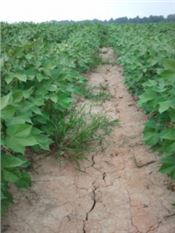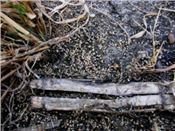|
Barnyardgrass Control In Mississippi Delta Crops
DR. JASON BOND
STONEVILLE, MISS.
Key Points To Remember: • Barnyardgrass populations collected following glyphosate failures in Mississippi have all been controlled in greenhouse research.
• Barnyardgrass control with glyphosate may be reduced by improper application timing, herbicide mixtures, poor spray water quality (pH or hard water), new emergence following application, or dry/wet conditions.
• Do not wait for barnyardgrass to emerge to decide how to control it. Use all the tools available, i.e., effective burndown, multiple effective herbicide modes of action, and well-timed applications.
Barnyardgrass is ranked in the top five of most common and troublesome weeds in Mississippi cotton, rice, and soybean. Barnyardgrass populations resistant to acetolactate synthase- (ALS)-inhibiting herbicides (herbicide Group 2) have been identified in most rice-producing counties in the Mississippi Delta. Most of these populations are also cross resistant to other ALS herbicides such as Regiment and Grasp.
Every year there are numerous complaints about barnyardgrass control with glyphosate. At the Southern Weed Science Society meeting in January, Larry Steckel reported that glyphosate-resistant barnyardgrass had been identified in west Tennessee. Barnyardgrass populations collected following glyphosate failures in Mississippi have all been controlled in greenhouse research. Genetic analyses indicate that glyphosate-resistant barnyardgrass may be present in Mississippi. This does not mean glyphosate-resistant barnyardgrass is present in Mississippi because (1) genetic research has not been concluded and (2) no plants from all suspected resistant populations have survived glyphosate in controlled research. However, it is common to hear that glyphosate performance on barnyardgrass is often poor in the Mississippi Delta.
The possibility that barnyardgrass in Mississippi may have evolved resistance to glyphosate is a definite concern, but there are other circumstances that may influence the level of barnyardgrass control with glyphosate. Among the causes of poor glyphosate performance on barnyardgrass are improper application timing, herbicide mixtures, poor spray water quality (pH or hard water), new emergence following application, or dry/wet conditions.
Herbicide mixtures can have a large influence on barnyardgrass control with glyphosate. Where we have collected barnyardgrass seed following control failures with glyphosate, the applications that failed always contained one or two herbicide products in addition to the glyphosate. In greenhouse research, we screen barnyardgrass response with treatments containing only glyphosate. So, we have observed control failures with glyphosate-based herbicide mixtures, but the surviving populations are controlled with glyphosate alone.
We have observed poor barnyardgrass control in multiple small-plot studies in the last few years. In one study, barnyardgrass control was lower 14, 21, and 28 days after application (DAT) with mixtures of glyphosate at 0.77 pounds acid equivalent per acre (Roundup PowerMax at 22 ounces per acre) plus fomesafen (Reflex, Flexstar) compared with glyphosate alone. That reduction in control was overcome by increasing the glyphosate rate to 1.16 pounds per acre (Roundup PowerMax at 33 ounces per acre). Dicamba reduced barnyardgrass control 7 and 14 DAT when added to both rates of glyphosate. We also observed variable barnyardgrass control in a study evaluating the influence of foliar fertilizer on glyphosate-based herbicide mixtures. In that research, the addition of a foliar fertilizer reduced barnyardgrass control 14 DAT when added to mixtures of glyphosate plus S-metolachlor (Dual Magnum), fomesafen, or Cobra.
In our research, barnyardgrass control is usually excellent with treatments that only contain glyphosate. However, glyphosate-only applications have no practical application where glyphosate-resistant Palmer amaranth is a problem. So, how can the problem of variable barnyardgrass control be addressed?
1. Use maximum glyphosate rate. Our research shows that poor barnyardgrass control with glyphosate-based herbicide mixtures can almost always be improved by increasing the glyphosate rate. Labeling for Roundup PowerMax allows single postemergence applications at 32 ounces per acre in cotton and 44 ounces per acre in soybean.
2. Utilize multiple effective herbicide modes of action. The addition of clethodim 0.047 pounds active ingredient per acre (Select Max at 6 ounces per acre) has consistently increased barnyardgrass control with glyphosate-based herbicide mixtures in small-plot research and in commercial field situations.
3. Include herbicides with postemergence and residual activity. Every spray application should contain multiple herbicide modes of action that exhibit postemergence and residual activity on barnyardgrass. Glyphosate plus S-metolachlor is a common mixture. S-metolachlor provides good to excellent residual control of barnyardgrass.
4. Time postemergence applications appropriately. Regardless of the herbicide mixture, timing is critical. Well-timed, early-season applications always provide the most consistent control. Barnyardgrass is often sprayed when it is too large, and this can be a recipe for failure. Barnyardgrass cannot be sprayed too early.
5. Prevent late-season escapes. If barnyardgrass plants are allowed to grow and produce seed late in the season or after harvest, those plants will contribute to weed soil seed bank. Those seed will contribute to problems in following years. ∆
DR. JASON BOND: Research/Extension Weed Scientist, Mississippi State University


|
|